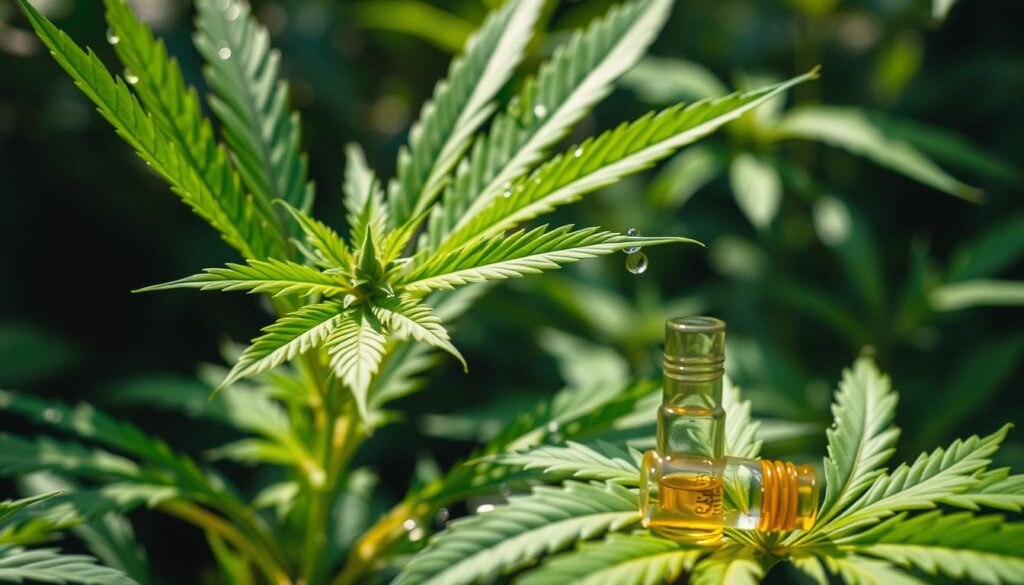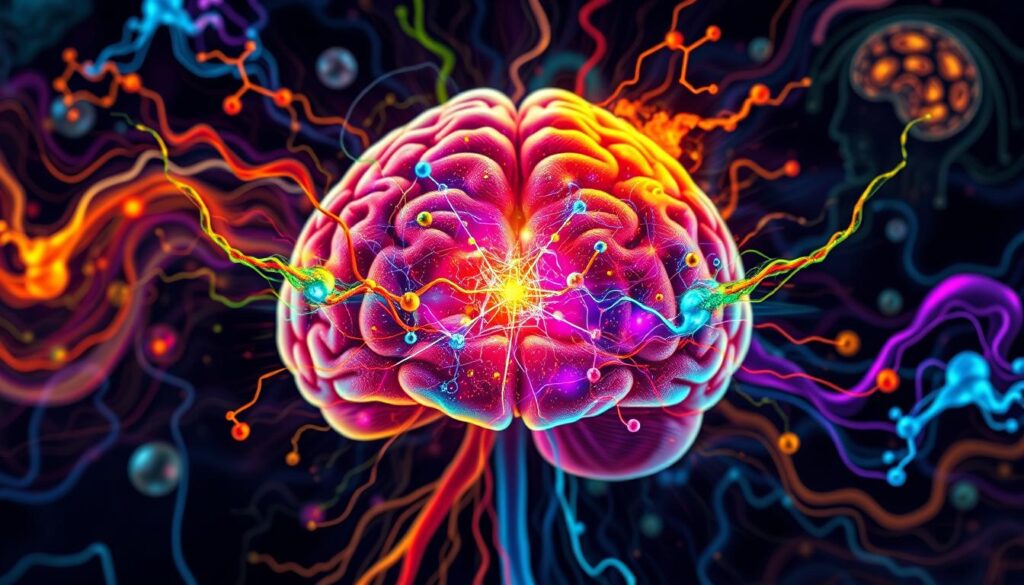Sativa extracts come from the Cannabis sativa plant. They are getting more attention for their possible health benefits. These extracts have many compounds, like THC and CBD, and terpenes. But what do these extracts do, and what benefits might they offer? Let’s dive into this interesting topic.
Key Takeaways
- Sativa extracts contain a variety of compounds, including cannabinoids, terpenes, and other phytochemicals.
- Preliminary research suggests sativa extracts may offer potential relief for a range of medical conditions, from pain and nausea to neurological disorders and inflammation.
- The effects and benefits of sativa extracts can vary widely depending on the specific composition and concentration of the compounds.
- More comprehensive studies are still needed to fully understand the efficacy and safety of sativa extracts for various applications.
- Consumers and healthcare providers should exercise caution and consult with qualified professionals when considering the use of sativa extracts.
What Does Sativa Extract Do?
Sativa extracts come from the Cannabis sativa plant. They have many compounds that might help with health issues. These include cannabinoids like THC and CBD, and terpenes and other chemicals.
Depending on what’s in them, sativa extracts might help with pain, nausea, and more. They could also help with neurological problems and inflammation.
There are over 80 active chemical compounds in Cannabis. The uses of sativa extracts depend on these compounds. In the European Union, growing Cannabis sativa L. is legal if it has less than 0.2% THC.
| Compound | Potential Benefits |
|---|---|
| Cannabinoids (THC, CBD) | Pain relief, anti-nausea, appetite stimulation, neurological disorder management |
| Terpenes | Anti-inflammatory, anxiolytic, and potential benefits for neurological disorders |
| Other Phytochemicals | Varied potential effects depending on the specific compounds |
But, we need more research to know for sure how sativa extracts work. We want to understand their full potential for helping people.

“Analgesia is mainly mediated by peripheral type 1 cannabinoid receptors in nociceptors.”
– Agarwal et al., Nat.Neurosci. 2007
Sativa Extract and Pain Relief
Chronic pain is a big problem, affecting 20.4% of adults in the US. People are looking for safe ways to manage pain. Sativa extract might be a solution for many.
Nabilone is a compound from the sativa plant. It helps with neuropathic pain. This is good news for those with multiple sclerosis and chemotherapy-induced neuropathy.
Studies show sativa-derived compounds can help with many chronic pain conditions. This is a big step forward in pain management. It gives hope to those looking for new ways to ease their pain.
| Statistic | Value |
|---|---|
| Increase in pain prevalence among adults in the US over the past two decades | 25% |
| Percentage of US adults with chronic pain in 2016 | 20.4% |
| Annual costs associated with chronic pain in the US | $560 billion |
| Increase in noncancer pain prevalence among US adults over the past two decades | 25% |
| Estimated number of Americans aged 12 or older who were current or past-month illicit drug users, including pain relievers | 22.6 million |
The opioid crisis makes finding new pain solutions urgent. Sativa extract and nabilone could be a safer option. They might help manage pain without the risks of opioids.
“Cannabis sativa has been used for medical, recreational, and spiritual purposes for thousands of years, and there has been an increasing amount of preclinical and clinical evidence about the beneficial pharmacological effects of cannabis, including pain relief.”
Sativa Extract for Nausea and Vomiting
Sativa-derived compounds, like nabilone, are great at fighting nausea and vomiting from chemotherapy. Studies show they work well for both sudden and delayed nausea and vomiting. This makes them a good choice or addition to other anti-nausea drugs.
Sativa Extract’s Anti-Emetic Effects
The anti-nausea effects of these compounds come from their action on the endocannabinoid system. This system is key in controlling nausea and vomiting. Most research has been on using sativa extract nausea vomiting in cancer patients, who often get these side effects from chemo.
A 2011 animal study found that cannabidiol (CBD) from sativa might help with nausea by affecting serotonin receptors. A 2016 human study showed that Sativex, a sativa compounds chemotherapy-induced nausea drug, helped people with chemotherapy nausea.
The American Cancer Society says nabilone anti-emetic effects are a treatment option for chemotherapy nausea and vomiting. They also help stimulate appetite in cancer patients.

“Sativa-derived compounds, such as nabilone, have been shown to effectively control both acute and delayed nausea and vomiting associated with cancer treatments.”
Sativa Extract and Multiple Sclerosis
Sativex is a medication made from sativa extracts and is used in some places for multiple sclerosis symptoms. It has THC and CBD in a balanced mix. Studies show it can reduce muscle stiffness and other symptoms in people with multiple sclerosis.
The benefits of Sativex come from its mix of cannabinoids and terpenes. These help manage multiple sclerosis symptoms. In two studies, 85 to 93 out of 100 people saw their spasticity improve with the cannabis extract. This is compared to 41 to 66 out of 100 without it.
Sativex and Spasticity in Multiple Sclerosis
Women with spasticity pain found relief with the cannabis extract. The study found no major downsides to using it for multiple sclerosis. There were no big differences in life expectancy, daily activities, or serious side effects between the groups.
The study didn’t have enough data on dizziness as a side effect. Yet, over 90 percent of people with MS have thought about using cannabis for their symptoms.

Nabiximols (Sativex®) is approved in Canada for MS-related pain. The CAMS study had 667 people with MS to test the cannabis extract. The MUSEC trial had 279 people, showing cannabis extract gave nearly double the relief from muscle stiffness compared to a placebo.
“The therapeutic benefits of Sativex are believed to be attributed to the synergistic effects of the various cannabinoids and terpenes found in the sativa-derived extract, which can help manage the complex neurological and muscular manifestations of multiple sclerosis.”
Sativa Extract and Appetite Stimulation
Sativa extracts might help increase appetite, which is good for people who lose weight due to illness. This includes those with cancer, HIV/AIDS, or other chronic diseases. THC in sativa extracts can make people hungrier, helping them eat more and stay healthy.
Research has looked into sativa extracts for boosting appetite. A study by Bielawiec et al. (2020) found that cannabidiol might help with obesity. Abioye et al. (2020) also found that Δ9-Tetrahydrocannabivarin (THCV) could help manage obesity and diabetes by controlling hunger.
More studies are needed to fully understand how sativa extracts work. But, they might be a useful treatment for appetite issues. De Lorenzo et al. (2019) and Marra et al. (2019) suggest using special tests to see how well these treatments work.
The appetite-stimulating effects of sativa compounds could help people with weight loss or wasting. De Lorenzo et al. (2020) pointed out that obesity is a preventable and treatable disease. Agha and Agha (2017) suggested public health policies to tackle obesity.
Even though the research is promising, it’s important to consider the risks and legal issues. Always talk to a doctor and stay updated on the latest research before using sativa extracts for appetite or medical reasons.

| Study | Key Findings |
|---|---|
| Bielawiec et al. (2020) | Discussed the potential of phytocannabinoids, particularly cannabidiol, as a possible treatment for obesity. |
| Abioye et al. (2020) | Explored the therapeutic benefits of Δ9-Tetrahydrocannabivarin (THCV) in managing obesity and diabetes. |
| De Lorenzo et al. (2019) and Marra et al. (2019) | Assessed body composition using bioelectrical impedance analysis and dual-energy X-ray absorptiometry. |
| De Lorenzo et al. (2020) | Identified obesity as a preventable, treatable, but relapsing disease. |
| Agha and Agha (2017) | Highlighted public health policy solutions for the rising prevalence of obesity. |
Sativa Extract and Neurological Disorders
Research is looking into sativa extracts, especially cannabidiol (CBD), for treating neurological disorders. Early studies show that neuroprotective and anti-inflammatory effects of sativa compounds might help. This could be true for epilepsy, Parkinson’s disease, and Alzheimer’s disease.
Sativa Extract and Neurological Symptoms
The endocannabinoid system plays a big role in neurological issues. Exogenous cannabinoids in sativa extracts work with CB1 and CB2 receptors. They might help with mitochondrial dysfunction, oxidative stress, neuroinflammation, and neurodegeneration in these conditions.
Though more research is needed, early results are promising. They suggest sativa extracts could be a treatment for complex neurological problems. Ongoing studies are looking into how cannabinoids can help manage symptoms and improve life for those with neurological disorders.
| Neurological Disorder | Potential Benefits of Sativa Extract |
|---|---|
| Epilepsy | Studies have suggested that an equilibrated mix of THC and CBD, as found in Sativex®, can be effective in managing ALS-related spasticity. |
| Parkinson’s Disease | Medical cannabis may have positive effects on both motor and non-motor symptoms in Parkinson’s disease patients, including reducing motor fluctuations and improving non-motor behaviors. |
| Alzheimer’s Disease | Medical cannabis could be beneficial in reducing neuroinflammation and cognitive impairment in Alzheimer’s disease patients. |
While the current research is encouraging, more studies are needed. We need to understand the efficacy and safety of sativa extracts for neurological conditions better.

Sativa Extract and Anxiety
Sativa extracts are being studied for their ability to reduce anxiety. Compounds like cannabidiol (CBD) in sativa plants may help with anxiety. These extracts could work by changing how our brain and body handle emotions.
Research on sativa extract for anxiety management is still early. But, it shows promise as a natural way to help with anxiety. Studies suggest sativa compounds for anxiety relief could be very helpful.
“Preliminary research has shown that certain compounds found in sativa extracts, such as cannabidiol (CBD), may have the potential to alleviate anxiety symptoms through their interaction with the endocannabinoid system and other neurological pathways.”
But, we need more research on sativa extracts for anxiety. We need to know more about their safety and how much to use. Always talk to a doctor before trying new treatments for anxiety.
| Study | Key Findings |
|---|---|
| A study on the consumption of cocoa flavanols | Resulted in acute improvements in mood and cognitive performance during sustained mental effort. |
| An analysis of the antimicrobial activity of flavonoids and saponins isolated from oats (avena sativa) | Showed positive results. |
| A comparative evaluation of anxiolytic effects of various extracts of oats, rice bran, and spinach in experimental animals | Was conducted. |
In conclusion, sativa extracts, especially CBD, might help with anxiety. This is a promising area of research. But, we need more studies to understand how they work and if they are safe for anxiety treatment.
Sativa Extract and Inflammation
Certain compounds in sativa extracts, like cannabidiol (CBD) and beta-caryophyllene, show strong anti-inflammatory properties. Studies have shown they work well in both lab tests and animal studies. These compounds interact with our body’s systems to reduce inflammation. This makes sativa extracts a promising treatment for many inflammatory conditions.
The Anti-Inflammatory Potential of Sativa Extracts
Studies have found that sativa-derived compounds, such as CBD and beta-caryophyllene, can modulate inflammatory responses. They do this by interacting with our body’s endocannabinoid system and other pathways. A study by Amarante-Mendes et al. showed how important these interactions are for our immune system.
Chen et al.’s research looked at inflammatory responses and inflammation-associated diseases in different parts of the body. They provided data on how common and impactful inflammation is in various systems. This research highlights the potential of sativa extracts to address a wide range of inflammatory conditions.
Cohen K. et al.’s clinical study explored the effects of cannabis and cannabinoids on health. They looked at the anti-inflammatory effects of cannabis use, among other things.
“Pre-treatment with cannabidiol (CBD), delta-9-tetrahydrocannabinol (THC), or extracts containing high levels of CBD or THC reduced the level of induction of various cytokines in inflammation. CBD was found to be more efficient than THC in reducing inflammation, and cannabis extracts were more efficient than pure cannabinoids in reducing inflammation.”
The evidence is growing that sativa extracts have great anti-inflammatory potential. They could be a good treatment for many inflammatory conditions. However, more research is needed to fully understand their efficacy and safety for this use.
Safety and Legal Status of Sativa Extracts
The safety and legality of sativa extracts depend on where you are and what’s in the extract. Sativa-derived compounds like CBD are usually safe. But, extracts with a lot of THC or other harmful substances can be risky.
The U.S. Food and Drug Administration (FDA) has sent warning letters to companies selling Delta-8 THC products. They also warned companies selling CBD for animals and humans without approval. This shows the strict rules around sativa extracts.
Rules on sativa extracts change over time and vary by place. For example, the FDA has only approved two cannabis-based drugs. One is for seizures in a rare disease, and the other for severe epilepsy.
Before using sativa extracts, check the laws in your area. Make sure to buy from trusted suppliers. The safety and legal status of sativa extracts remain a complex and evolving issue that requires careful consideration.
| Statistic | Value |
|---|---|
| Percentage of companies warned by the FDA for illegally selling copycat food products containing Delta-8 THC | 100% |
| Number of companies warned for illegally selling CBD products intended for use in food-producing animals | Four |
| FDA-approved drug containing an active ingredient derived from cannabis to treat seizures in rare genetic disease | One |
| FDA-approved drug comprised of an active ingredient derived from marijuana to treat rare, severe forms of epilepsy | One |
Remember, the safety and legality of sativa extracts can change a lot. Always check the laws in your area before using them. Buying from trusted suppliers is key to staying safe and legal.
“Limiting the use of high-THC cannabis extracts and opting for products with lower THC levels can reduce the risks of dependence and mental health issues.”
Conclusion
Sativa extracts come from the Cannabis sativa plant and are getting more attention. They might help with pain, nausea, and even some neurological issues. This is because they contain many compounds like cannabinoids and terpenes.
Even though early studies show promise, we need more research. It’s important for both users and doctors to be careful. This is because the quality and rules around these extracts can change a lot.
As scientists learn more, we’ll understand how to use sativa extracts better. This knowledge will help make these extracts safer and more effective for health problems. It’s an exciting area to watch as research grows.





